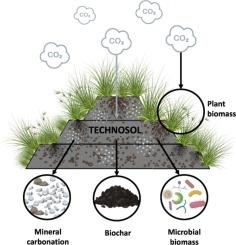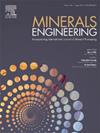评估利用采煤废料建造的 Technosol 进行二氧化碳封存的情况
IF 4.9
2区 工程技术
Q1 ENGINEERING, CHEMICAL
引用次数: 0
摘要
本文提出利用煤炭废料和战略材料构建的技术溶胶来加强二氧化碳封存和恢复退化地区。对碳捕集的评估考虑了四种方法:(i) 由 Megathyrsus Maximus cv. Mombasa 产生的植物干物质;(ii) 通过生物炭加入碳;(iii) 微生物生物质碳;(iv) 通过石灰进行矿物固碳。矿区的当地土壤被用作对照。结果显示,技术溶胶的土壤肥力参数符合巴西的指导方针。植物生长随着生物炭的加入而增加,但仍低于对照土壤。pH 值、化学成分和矿物成分数据与地球化学反应相结合,显示了煤炭废物化合物(主要是黄铁矿)与石灰的相互作用。在计算二氧化碳捕集潜力方面,生物炭和矿物碳化是与设计系统最相关的方法。获得的最佳性能可捕获约 65 吨二氧化碳当量公顷-1,比传统用于回收废物处理区的系统高出约四倍。该研究证明了将采矿场地回收、废物处置和排放减缓整合到一个封闭系统中的可行性,为煤炭开采业提供了可持续的选择。本文章由计算机程序翻译,如有差异,请以英文原文为准。

Evaluating CO2 sequestration through Technosol constructed from coal mining waste
This paper proposes enhancing CO2 sequestration and recovering degraded areas using Technosols constructed with coal waste and strategic materials. The evaluation of carbon capture considered four methods: (i) plant dry mass produced by Megathyrsus Maximus cv. Mombasa (ii) carbon incorporation via biochar, (iii) microbial biomass carbon, and (iv) mineral sequestration by lime. Local soil from the mine site was used as a control. Results show soil fertility parameters of the Technosols according to Brazilian guidelines. Plant growth increased with biochar incorporation but was still lower than in control soil. The pH, chemical, and mineralogical composition data were combined with geochemical reactions, showing the interaction of coal waste compounds, mainly pyrite with lime. Regarding calculating the CO2 capture potential, biochar and mineral carbonation were the most relevant means for the designed system. The best performance obtained can capture approximately 65 t CO2eq ha−1, about four times greater than the systems traditionally used to recover waste disposal areas. The study demonstrates the feasibility of incorporating mining site recovery, waste disposal, and emissions mitigation in a closed system, providing sustainable options for the coal mining industry.
求助全文
通过发布文献求助,成功后即可免费获取论文全文。
去求助
来源期刊

Minerals Engineering
工程技术-工程:化工
CiteScore
8.70
自引率
18.80%
发文量
519
审稿时长
81 days
期刊介绍:
The purpose of the journal is to provide for the rapid publication of topical papers featuring the latest developments in the allied fields of mineral processing and extractive metallurgy. Its wide ranging coverage of research and practical (operating) topics includes physical separation methods, such as comminution, flotation concentration and dewatering, chemical methods such as bio-, hydro-, and electro-metallurgy, analytical techniques, process control, simulation and instrumentation, and mineralogical aspects of processing. Environmental issues, particularly those pertaining to sustainable development, will also be strongly covered.
 求助内容:
求助内容: 应助结果提醒方式:
应助结果提醒方式:


